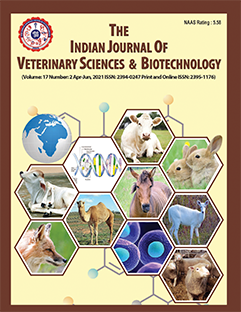Assessing the Prevalence of Hard Ticks in Dairy Cattle Across Diverse Agro-Climatic Zones of Western Maharashtra
DOI:
https://doi.org/10.48165/ijvsbt.21.2.17Keywords:
Bhagyashree Harihar Belsare, Prashant Dhanaji Pawar, Gajanan Madhavrao Chigure, Prashant Patilba Mhase, Nirja Ranjeet Mhaisekar, Vitthal Shrirang DhaygudeAbstract
This study investigated the prevalence of hard ticks infesting dairy cattle across four distinct agro-climatic zones in Western Maharashtra, India, shedding light on critical challenges in livestock management. From June to February, a thorough screening of 375 dairy cattle was conducted, with a meticulous collection of ticks from various regions of the body as well as from the surrounding environment. The findings revealed that out of 375, 200 animals were infested, indicating an alarming overall prevalence of 53.30%. Notably, calves under one year showed even greater susceptibility, with infestation rates soaring to 70.00%. Among different demographics, female cattle experienced higher infestation levels (54.60%; 160/293) compared to males (48.80%; 40/82). The prevalence in crossbred animals was 59.70% (12/206), non-descript breeds 45.70% (42/92), and in native breeds 45.50% (35/77). Cattle in poor body condition were disproportionately affected, exhibiting a striking 76.40% (81/106) infestation rate, in contrast to those in medium or good condition. Ticks favoured specific sites on the host, with the neck region (38.50%) and ears (15.50%) identified as the most common areas of infestation. This research underscores the urgent need for targeted control strategies to mitigate tick infestations in dairy cattle, particularly among vulnerable populations.Downloads
References
BAHS (2019). Basic Animal Husbandry Statistics, Department of Animal Husbandry, Dairying & Fishery, Ministry of Agriculture and Farmers Welfare, Govt. of India, New Delhi.
Dehuri, M., Panda, M.R., Mohanty, B., Hembram, A., Mahapatra, T., & Sahu, A. (2017). Ixodid ticks infesting cattle and associated risk factors in coastal districts of Odisha. Journal of Entomology and Zoology Studies, 5(4), 129-132.
Ghosh, S., Patra, G., Borthakur, S. K., Behera, P., Tolenkhomba, T. C., Das, M., & Lalnunpuia, C. (2019). Prevalence of hard tick infestations in cattle of Mizoram, India. Biological Rhythm Research, 50(4), 564-574.
Godara, R., Katoch, R., & Yadav, A. (2018). Prevalence of ixodid ticks in cattle of Jammu region. Veterinary Practitioner, 19(1), 27-28. Hurtado, O.J.B., & Giraldo-Ríos, C. (2018). Economic and health impact of the ticks in production animals. Ticks and Tick-borne Pathogens, 9, 1-9.
Jaliparthi, J., Manchukonda, U.K., Murthy, S.G., Putty, K., & Gonepudi, N.K. (2023). Influence of animal factors on the prevalence of ixodid ticks on cattle in Telangana state, India. Journal of Animal Research, 13(3), 451-455.
Jawale, C.S., Dama, L.B., & Dama, S.B. (2012). Prevalence of Ixodid ticks in post-acaricide treated cattle and buffaloes at Sinner District, Nashik (MS), India. Trends in Parasitology Research, 1(1), 20-24.
Kaur, P., Juyal, P.D., Sharma, A., Bal, M.S., & Singla, L.D. (2016). Seroprevalence of Babesia bigemina in dairy animals from low lying regions of Punjab, India. Indian Journal of Animal Research, 50(3), 406-410.
Kemal, J., Tamerat, N., & Tuluka, T. (2016). Infestation and identification of ixodid ticks in cattle: The case of Arbegona District, southern Ethiopia. Journal of Veterinary Medicine, 2016, 1-8.
Kumar, R., Sharma, A. K., & Ghosh, S. (2020). Menace of acaricide resistance in cattle tick, Rhipicephalus microplus in India: Status and possible mitigation strategies. Veterinary Parasitology, 278, 108993.
Mandloi, U.K., Jayraw, A.K., Haque, M., & Jamra, N. (2016). Prevalence of Ixodid ticks in cattle population of Indore, Madhya Pradesh. Indian Journal of Veterinary Sciences & Biotechnology, 12(2), 62-65.
Ntesang, K., Kaur, P., Arora, J.S., Kashyap, N., & Singla, L.D. (2024). Comparative performance and evaluation of two molecular assays and conventional detection of Theileria annulata in bovines. Indian Journal of Animal Research, 58(3), 490-494.
Salih, D.A., El-Hussein, A.M., & Singla, L.D. (2015). Diagnostic approaches for tick-borne haemoparasitic diseases in livestock. Journal of Veterinary Medicine and Animal Health, 7(2), 45-56.
Sen, P.C., Farjana, T., Khatun, F., Yasin, M.G., Rahman, M.A., Akter, M.T.D., Mondal, M.M.H., & Alim, M.A. (2012). A cross-sectional study on the tick infestation in cattle in Faridpur district of Bangladesh. Bangladesh Veterinary Journal, 46(1-4), 19-30.
Sharma, A.A., Singla, L.D., Kaur, P., Bal, M.S., Batth, B.K., & Juyal, P.D. (2013). Prevalence and haemato-biochemical profile of Anaplasma marginale infection in dairy animals of Punjab (India). Asian Pacific Journal of Tropical Medicine, 6(2), 139-144.
Sharma, A., Singla, L.D., Tuli, A., Kaur, P., & Bal, M.S. (2015). Detection and assessment of risk factors associated with natural concurrent infection of Trypanosoma evansi and Anaplasma marginale in dairy animals by duplex PCR in eastern Punjab. Tropical Animal Health and Production, 47, 251-257.
Shirsikar, P.M., Narladkar, B.W., Jadhav, N.D., Rajurkar, S.R., Jadhav, S.G., Channa, G.R., Gaikawad, S.S., & Chigure, G.M. (2023). Morphological characterization and prevalence of hard ticks infesting cattle of Marathwada Region, Maharashtra state, India. Journal of Experimental Zoology India, 26(2), 25-27.
Singh, A.P., Singla, L.D., & Singh, A. (2000). A study on the effects of macroclimatic factors on the seasonal population dynamics of Boophilus micropus (Canes, 1888) infesting the cross-bred cattle of Ludhiana district. International Journal of Animal Science,
15(1), 29-31.
Soulsby, E.J.L. (1982). Helminths, Arthropods, and Protozoa of Domesticated Animals. 7th Edition, Bailliere Tindall, London.
Downloads
Published
Issue
Section
License
Copyright (c) 2025 Indian Journal of Veterinary Sciences and Biotechnology

This work is licensed under a Creative Commons Attribution-NonCommercial-NoDerivatives 4.0 International License.




